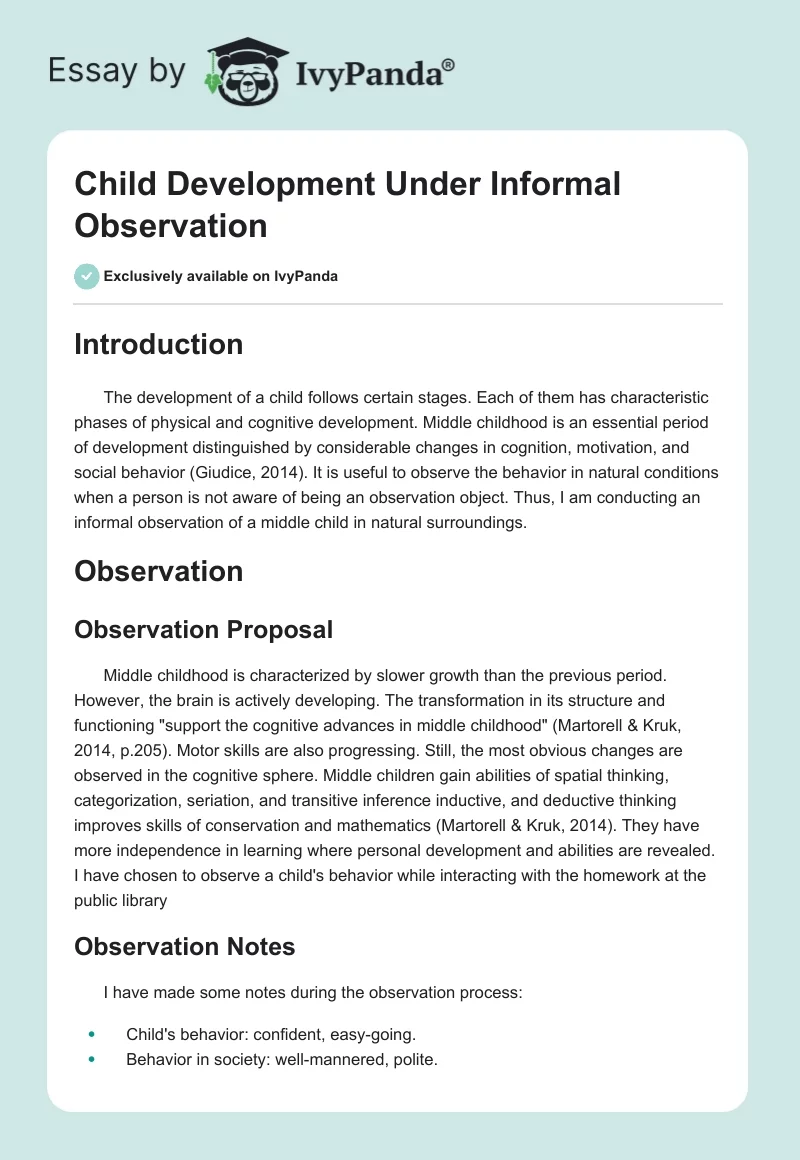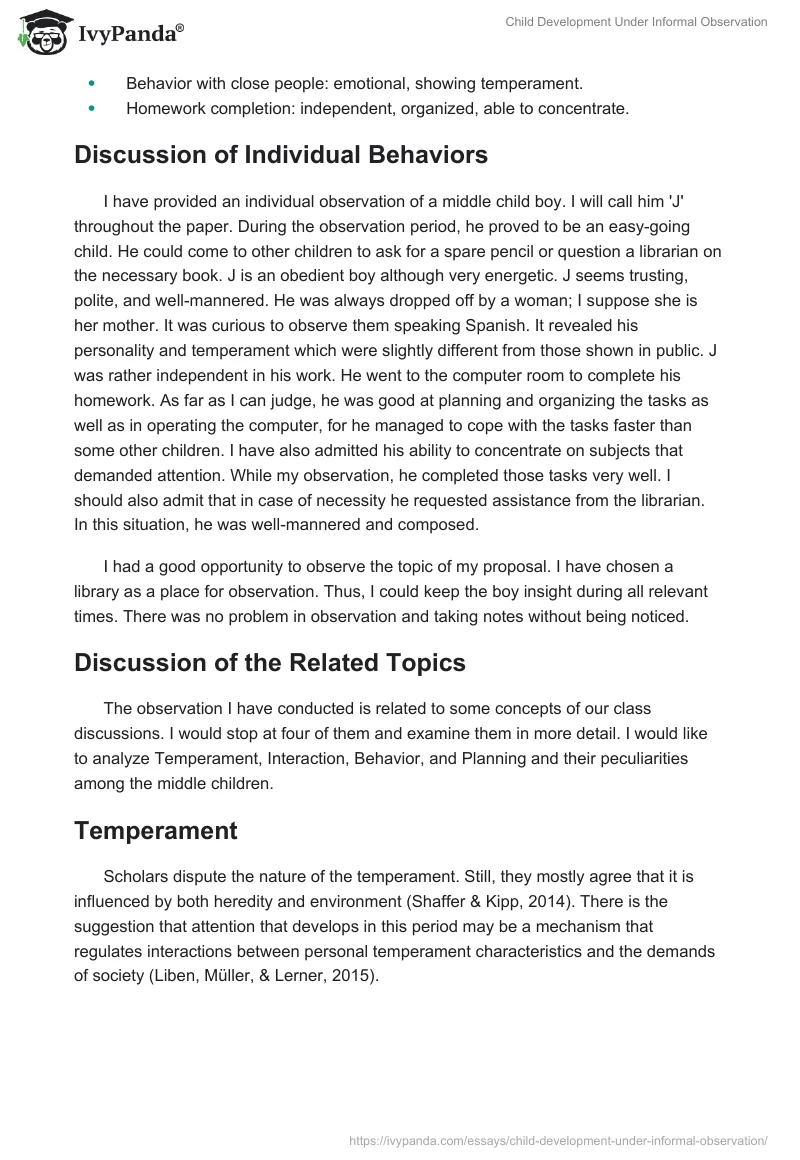Introduction
The development of a child follows certain stages. Each of them has characteristic phases of physical and cognitive development. Middle childhood is an essential period of development distinguished by considerable changes in cognition, motivation, and social behavior (Giudice, 2014). It is useful to observe the behavior in natural conditions when a person is not aware of being an observation object. Thus, I am conducting an informal observation of a middle child in natural surroundings.
Observation
Observation Proposal
Middle childhood is characterized by slower growth than the previous period. However, the brain is actively developing. The transformation in its structure and functioning “support the cognitive advances in middle childhood” (Martorell & Kruk, 2014, p.205). Motor skills are also progressing. Still, the most obvious changes are observed in the cognitive sphere. Middle children gain abilities of spatial thinking, categorization, seriation, and transitive inference inductive, and deductive thinking improves skills of conservation and mathematics (Martorell & Kruk, 2014). They have more independence in learning where personal development and abilities are revealed. I have chosen to observe a child’s behavior while interacting with the homework at the public library
Observation Notes
I have made some notes during the observation process:
- Child’s behavior: confident, easy-going.
- Behavior in society: well-mannered, polite.
- Behavior with close people: emotional, showing temperament.
- Homework completion: independent, organized, able to concentrate.
Discussion of Individual Behaviors
I have provided an individual observation of a middle child boy. I will call him ‘J’ throughout the paper. During the observation period, he proved to be an easy-going child. He could come to other children to ask for a spare pencil or question a librarian on the necessary book. J is an obedient boy although very energetic. J seems trusting, polite, and well-mannered. He was always dropped off by a woman; I suppose she is her mother. It was curious to observe them speaking Spanish. It revealed his personality and temperament which were slightly different from those shown in public. J was rather independent in his work. He went to the computer room to complete his homework. As far as I can judge, he was good at planning and organizing the tasks as well as in operating the computer, for he managed to cope with the tasks faster than some other children. I have also admitted his ability to concentrate on subjects that demanded attention. While my observation, he completed those tasks very well. I should also admit that in case of necessity he requested assistance from the librarian. In this situation, he was well-mannered and composed.
I had a good opportunity to observe the topic of my proposal. I have chosen a library as a place for observation. Thus, I could keep the boy insight during all relevant times. There was no problem in observation and taking notes without being noticed.
Discussion of the Related Topics
The observation I have conducted is related to some concepts of our class discussions. I would stop at four of them and examine them in more detail. I would like to analyze Temperament, Interaction, Behavior, and Planning and their peculiarities among the middle children.
Temperament
Scholars dispute the nature of the temperament. Still, they mostly agree that it is influenced by both heredity and environment (Shaffer & Kipp, 2014). There is the suggestion that attention that develops in this period may be a mechanism that regulates interactions between personal temperament characteristics and the demands of society (Liben, Müller, & Lerner, 2015).
Interaction
Middle childhood is the age of first school experiences. They are crucial for further child’s interactions. The social environment starts taking more time than the family. The interaction in this period is under the influence of other developmental factors. For example, due to increasing gender identification, boys may reveal more negative interactions than girls (Martorell and Kruk, 2014).
Behavior
Behavior, especially social, is a component that changes in middle childhood. It is the age when children gain social norms, are able to complex moral reasoning, observe individual changes in levels of aggression. Moreover, the sense of gender identity increases. It influences the behavior in social play (Giudice, 2014). In the social context, children are expected to demonstrate responsible behavior. Apart from it, Martorell and Kruk (2014) mention that children can “plan and monitor their behavior” (222). They also call the suitable behavior intelligent.
Planning
Children learn to plan their activities during their school years. They are already aware of the work of memory, which allows them to use planning and strategies (Martorell and Kruk, 2014). Planning is also enabled by brain development. It is one of the executive functions which develop together with self-regulation as a part of cognitive skills formation. Best, Miller and Jones (as cited in Giudice, 2014) state that “children become much more capable of inhibiting unwanted behavior, maintaining sustained attention, making and following plans (p.4).
Strengths and Weaknesses of a Natural Observation
Natural observation is a proper method to examine the object in the usual surrounding. However, it has both advantages and disadvantages. The strength of an informal observation is that it can be done without too much preparation or a lot of planning and expense. Apart from it, such observation is less stressful for the person in focus. It helps to observe the natural reactions in the natural environment without intrusion. It enables an observer to get immediate data and in case of necessity make changes in the observation plane. Despite some strengths, the weaknesses should also be mentioned. The observer may become intolerant and thus subjective. Besides, this type of observation is time-consuming. It is also difficult to control and often due to the necessity of keeping it natural the observer is rather far from the object. Thus, some important aspects may be missed.
The research is, of course, not complete. I would suggest two directions for its continuation. Thus, further research may be continued with the same object in a different environment. It will enable a more precise behavior evaluation. Moreover, the research could be made longitude. It might be interesting to observe the personal changes of the boy from middle age to adolescence.
Conclusions
On the whole, the informal observation is a useful experience. It gives a unique opportunity to study the object in the natural environment. Still, the limitations are evident. It can be conducted mostly in public places to preserve its natural character. The only concern I had during the observation was that someone could notice what I was doing. Nevertheless, it is a perfect method to investigate natural behavioral reactions. I had an opportunity to study the everyday behavior of a middle child. Another type of research would not be so informative as children do not always act naturally with the people they do not know.
References
Giudice, M.D. (2014). Middle childhood: An evolutionary-developmental synthesis. Child developmental Perspectives, 1-8.
Liben, L.S., Müller, U., & Lerner, R.M. (Eds.). (2015). Handbook on child psychology and developmental processes (Vol.2). Hoboken, NJ: John Wiley & Sons, Inc.
Martorell, G., & Kruk, R. (2014). Child: From birth to adolescence. Burr Ridge, IL: McGraw-Hill Education.
Shaffer, D., & Kipp, K. (2014). Developmental Psychology: Childhood and adolescence (9th ed.). Belmont, CA: Cengage Learning.


